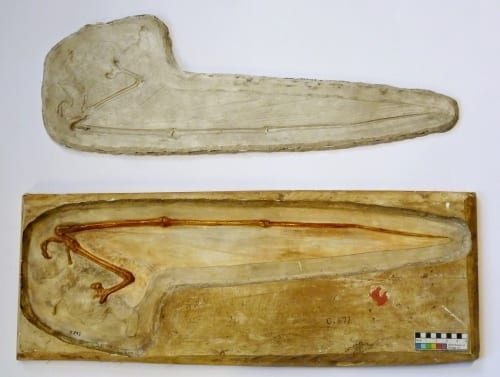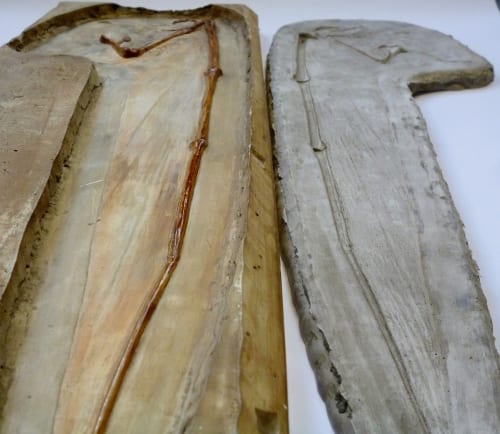Specimen of the Week 191 : Rhamphorhynchus wing cast
By Tannis Davidson, on 8 June 2015
One of my favourite pastimes is to do a bit of research – on just about anything. I enjoy investigative work and the process of discovery. Luckily, the nature of my work at the Grant Museum ensures that there are plenty of opportunities to do museum-detective work. It could be a case of matching up an archival record with an unaccessioned specimen or figuring out a valid taxonomic name for a mysterious beast in a jar.
It is both a burden and a blessing to work with historic collections which have varying degrees of documentary information: while it would be preferable to have more/most/all information about an object, gaps in the data allow for additional research and new discoveries.
Recently I was doing some research on another Grant Museum Rhamphorhynchus specimen and one thing led to another…and another…and another. It turns out that there is a lot of history behind this week’s SOTW – and although it is ‘only’ a plaster cast – it is part of a famous lineage of one of the most famous fossil finds!
This week’s Specimen of the Week is…
**The Rhamphorhynchus wing cast**
1. Pterosaurs
Pterosaurs were flying reptiles which existed from the late Triassic to the end of the Cretaceous Period (228 – 66 million years ago). They were the earliest known vertebrates to have evolved powered flight with wings formed by a membrane of skin, tissues and muscles. The order Pterosauria included at least 100 different species including the well known genera Pterodactylus, Pteranodon and Quetzalcoatlus.
2. “Beak snout”
Within this order, Rhamphorhynchus (“beak snout”) was a genus of long-tailed pterosaurs which lived in the Jurassic Period around 201-145 million years ago. The taxonomy of Rhamphorhynchus has a long history of reclassification under a variety of species names but most researchers now recognise a single species, Rhamphorynchus muensteri. This is largely the result of research by S. Christopher Bennett (1995) who argued that different species “fall into discrete size-classes that are year-classes resulting from seasonal mortality or preservation of specimens” 1.
3. Karl Alfred von Zittel
One of the giants of palaeontology, Karl Alfred von Zittel (1839-1904) was, by 1880, professor of palaeontology at the University of Munich with the charge of the state collection of fossils. In 1882 he described a specimen of a single complete pterosaur wing found in the Jurassic lithographic limestone of the Solnhofen Lagerstätten. This exquisitely preserved specimen showed the imprints of the membrane including the actinofibrils, which are the strenghtening fibres (overlain in criss-crossing layers) providing strength to the wing. In addition to the detail preserved in the wing, the overall size, shape and width was now known. It was a significant find then, and to this day is still arguably the best preserved patagium (wing membrane) of a pterosaur.
4. Zittel wing cast
This sensational specimen was (and still is) known as the “Zittel wing”. Almost immediately, casts were distributed to major museums around the world and by 1883, most researchers and interested students had seen the wing. Our SOTW is actually two parts – the plaster cast and its silicon-rubber mould:
While we are not quite sure when they date from (or when exactly they came to the Grant Museum) – we do know with certainty that the plaster cast WAS made from this mould. As is the nature the material, plaster is quite easy to cast but doesn’t capture the finest detail. This is evident upon comparison between the plaster cast and the mould (which has more detail of the membrane to the eye and the touch).
4. Tbc…
I optimistically anticipate new and exciting findings to emerge as I continue with my GMZ-Rhamphorhynchus-research-junket. Tune in for my next SOTW post to learn more…
Tannis Davidson is Curatorial Assistant at the Grant Museum of Zoology
References
1. Bennett, S.C. (1995). “A Statistical Study of Rhamphorhynchus from the Solnhofen Limestone of Germany: Year-Classes of a Single Large Species”. Journal of Paleontology, Vol. 69. No.3 (May 1995), pp. 569-580
2. von Zittel, K. A. (1882). “Über die Flugsaurier (Ptero-dactylen) aus dem lithographischen Schiefer Bayerns,” in Palaeontographica, 29, pp.47-80 & pls 10-13
2 Responses to “Specimen of the Week 191 : Rhamphorhynchus wing cast”
- 1
-
2
Specimen of the Week 196 : A Real Fossil Pterosaur | UCL Museums & Collections Blog wrote on 13 July 2015:

[…] my last post, I wrote about our ‘Zittel wing’ pterosaur cast and mentioned that I was doing a bit of research on another Grant Museum Rhamphorhynchus specimen. […]
 Close
Close







[…] UCL: Museums and Collections Blog: Specimen of the Week 191: Rhaphorhynchus wing cast […]